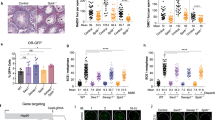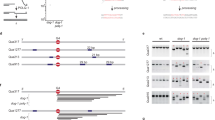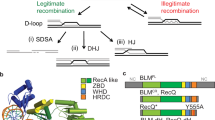Abstract
Mutations in BLM, which encodes a RecQ helicase, give rise to Bloom's syndrome, a disorder associated with cancer predisposition and genomic instability1. A defining feature of Bloom's syndrome is an elevated frequency of sister chromatid exchanges2. These arise from crossing over of chromatid arms during homologous recombination, a ubiquitous process that exists to repair DNA double-stranded breaks and damaged replication forks. Whereas crossing over is required in meiosis, in mitotic cells it can be associated with detrimental loss of heterozygosity. BLM forms an evolutionarily conserved complex with human topoisomerase IIIα (hTOPO IIIα)3,4, which can break and rejoin DNA to alter its topology. Inactivation of homologues of either protein leads to hyper-recombination in unicellular organisms5. Here, we show that BLM and hTOPO IIIα together effect the resolution of a recombination intermediate containing a double Holliday junction. The mechanism, which we term double-junction dissolution, is distinct from classical Holliday junction resolution and prevents exchange of flanking sequences. Loss of such an activity explains many of the cellular phenotypes of Bloom's syndrome. These results have wider implications for our understanding of the process of homologous recombination and the mechanisms that exist to prevent tumorigenesis.
This is a preview of subscription content, access via your institution
Access options
Subscribe to this journal
Receive 51 print issues and online access
$199.00 per year
only $3.90 per issue
Buy this article
- Purchase on SpringerLink
- Instant access to full article PDF
Prices may be subject to local taxes which are calculated during checkout




Similar content being viewed by others
References
Ellis, N. A. et al. The Bloom's Syndrome gene product is homologous to RecQ helicases. Cell 83, 655–666 (1995)
Chaganti, R. S., Schonberg, S. & German, J. A manyfold increase in sister chromatid exchanges in Bloom's syndrome lymphocytes. Proc. Natl Acad. Sci. USA 71, 4508–4512 (1974)
Wu, L. et al. The Bloom's syndrome gene product interacts with topoisomerase III. J. Biol. Chem. 275, 9636–9644 (2000)
Johnson, F. B. et al. Association of the Bloom syndrome protein with topoisomerase IIIα in somatic and meiotic cells. Cancer Res. 60, 1162–1167 (2000)
Wu, L. & Hickson, I. D. RecQ helicases and topoisomerases: components of a conserved complex for the regulation of genetic recombination. Cell. Mol. Life Sci. 58, 894–901 (2001)
Harmon, F. G., DiGate, R. J. & Kowalczykowski, S. C. RecQ helicase and topoisomerase III comprise a novel DNA strand passage function: a conserved mechanism for control of DNA recombination. Mol. Cell 3, 611–620 (1999)
Wu, L. & Hickson, I. D. The Bloom's syndrome helicase stimulates the activity of human topoisomerase III α. Nucleic Acids Res. 30, 4823–4829 (2002)
Karow, J. K., Constantinou, A., Li, J. L., West, S. C. & Hickson, I. D. The Bloom's syndrome gene product promotes branch migration of Holliday junctions. Proc. Natl Acad. Sci. USA 97, 6504–6508 (2000)
Gangloff, S., de Massy, B., Arthur, L., Rothstein, R. & Fabre, F. The essential role of yeast topoisomerase III in meiosis depends on recombination. EMBO J. 18, 1701–1711 (1999)
Benson, F. E. & West, S. C. Substrate specificity of the Escherichia coli RuvC protein. Resolution of three- and four-stranded recombination intermediates. J. Biol. Chem. 269, 5195–5201 (1994)
Lloyd, R. G. & Sharples, G. J. Processing of recombination intermediates by the RecG and RuvAB proteins of Escherichia coli. Nucleic Acids Res. 21, 1719–1725 (1993)
Fu, T. J., Tse-Dinh, Y. C. & Seeman, N. C. Holliday junction crossover topology. J. Mol. Biol. 236, 91–105 (1994)
Schwacha, A. & Kleckner, N. Identification of double Holliday junctions as intermediates in meiotic recombination. Cell 83, 783–791 (1995)
Szostak, J. W., Orr-Weaver, T. L., Rothstein, R. J. & Stahl, F. W. The double-strand-break repair model for recombination. Cell 33, 25–35 (1983)
Constantinou, A., Chen, X. B., McGowan, C. H. & West, S. C. Holliday junction resolution in human cells: two junction endonucleases with distinct substrate specificities. EMBO J. 21, 5577–5585 (2002)
Constantinou, A., Davies, A. A. & West, S. C. Branch migration and Holliday junction resolution catalyzed by activities from mammalian cells. Cell 104, 259–268 (2001)
West, S. C. Processing of recombination intermediates by the RuvABC proteins. Annu. Rev. Genet. 31, 213–244 (1997)
Goulaouic, H. et al. Purification and characterization of human DNA topoisomerase IIIα. Nucleic Acids Res. 27, 2443–2450 (1999)
Karow, J. K., Chakraverty, R. K. & Hickson, I. D. The Bloom's syndrome gene product is a 3′-5′ DNA helicase. J. Biol. Chem. 272, 30611–30614 (1997)
Allers, T. & Lichten, M. Differential timing and control of noncrossover and crossover recombination during meiosis. Cell 106, 47–57 (2001)
Johnson, R. D. & Jasin, M. Sister chromatid gene conversion is a prominent double-strand break repair pathway in mammalian cells. EMBO J. 19, 3398–3407 (2000)
Osman, F., Dixon, J., Doe, C. L. & Whitby, M. C. Generating crossovers by resolution of nicked Holliday junctions: a role for Mus81-Eme1 in meiosis. Mol. Cell 12, 761–774 (2003)
Paques, F. & Haber, J. E. Multiple pathways of recombination induced by double-strand breaks in Saccharomyces cerevisiae. Microbiol. Mol. Biol. Rev. 63, 349–404 (1999)
Ira, G., Malkova, A., Liberi, G., Foiani, M. & Haber, J. E. Srs2 and Sgs1-Top3 suppress crossovers during double-strand break repair in yeast. Cell 115, 401–411 (2003)
Nasmyth, K. A. Molecular genetics of yeast mating type. Annu. Rev. Genet. 16, 439–500 (1982)
Bachrati, C. Z. & Hickson, I. D. RecQ helicases: suppressors of tumorigenesis and premature aging. Biochem. J. 374, 577–606 (2003)
Luo, G. et al. Cancer predisposition caused by elevated mitotic recombination in Bloom mice. Nature Genet. 26, 424–429 (2000)
Hickson, I. D. RecQ helicases: caretakers of the genome. Nature Rev. Cancer 3, 169–178 (2003)
Acknowledgements
We thank H. Goulaouic, J.-F. Riou and S. Matson for proteins, and members of the Genomic Integrity Group for useful discussions. We also thank J. Haber, S. C. West, E. Louis, P. McHugh and R. Borts for comments on the manuscript, and J. Haber for communicating results before publication. This work is supported by the Cancer Research UK.
Author information
Authors and Affiliations
Corresponding author
Ethics declarations
Competing interests
The authors declare that they have no competing financial interests.
Supplementary information
Rights and permissions
About this article
Cite this article
Wu, L., Hickson, I. The Bloom's syndrome helicase suppresses crossing over during homologous recombination. Nature 426, 870–874 (2003). https://doi.org/10.1038/nature02253
Received:
Accepted:
Issue Date:
DOI: https://doi.org/10.1038/nature02253



